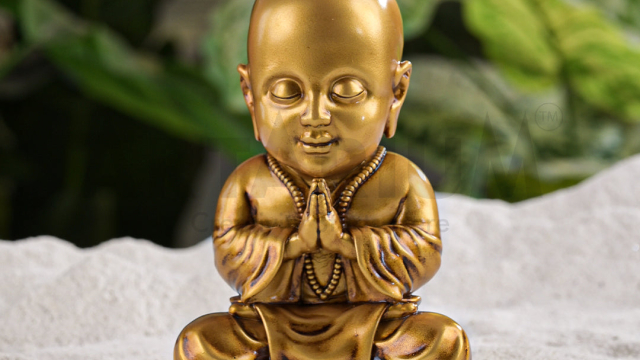Introduction:
In the vast landscape of spiritual symbolism, the image of the Meditating Little Buddha emerges as a beacon of tranquility and wisdom. This representation, capturing the essence of mindfulness and contemplation, holds a universal appeal that transcends cultures and resonates with individuals seeking inner peace. In this exploration, we will delve into the significance of the Meditating Little Buddha, uncovering the profound lessons it imparts and the relevance it holds in fostering a harmonious and mindful life.

The Symbolic Presence of the Meditating Little Buddha:
The Meditating Little Buddha, often depicted in art and sculpture, encapsulates the spirit of Siddhartha Gautama, who later became the Buddha. This particular portrayal focuses on his early years, embodying the journey of a child seeking profound truths amidst the simplicity of youth. The image typically features the young Buddha seated in a meditative posture, radiating a sense of peace and enlightenment that belies his tender age.
Significance of the Meditating Little Buddha:
- Innocence and Purity: The Meditating Little Buddha symbolizes the inherent purity and innocence of childhood. In a world often fraught with complexities, this representation serves as a reminder that even the youngest among us can access a state of tranquility and simplicity.
- Early Embarkation on the Spiritual Path: Much like the Meditating Baby Buddha, the Little Buddha signifies the commencement of a spiritual journey from a tender age. It embodies the idea that the pursuit of inner peace and enlightenment is not restricted by age, and even the youngest minds can engage in practices that nurture spiritual growth.
- Teaching Mindfulness to Children: The Meditating Little Buddha carries a profound message about introducing mindfulness to children. It encourages parents, educators, and caregivers to instill practices of presence, self-awareness, and contemplation in the formative years, laying a foundation for a balanced and mindful life.
Relevance in Modern Times:
In an era characterized by constant stimuli and a fast-paced lifestyle, the image of the Meditating Little Buddha remains highly relevant. Here’s how the essence of the Little Buddha can be applied to contemporary living:
- Early Introduction to Mindfulness: Incorporating mindfulness practices into a child’s routine can have lasting positive effects. The Meditating Little Buddha serves as a visual representation, inspiring parents and educators to introduce simple mindfulness exercises to help children navigate their thoughts and emotions.
- Cultivating Emotional Intelligence: The Little Buddha embodies emotional intelligence by displaying a calm and composed demeanor. Encouraging children to understand and manage their emotions is a crucial aspect of their development, fostering resilience, empathy, and healthy relationships.
- Fostering Creativity and Imagination: The simplicity of the Meditating Little Buddha can also inspire creativity and imagination in children. By encouraging them to explore their inner worlds and embrace moments of stillness, parents and caregivers contribute to the holistic development of a child’s mind.
The Meditating Little Buddha as a Guide:
Beyond its visual appeal, the Meditating Little Buddha serves as a guide for individuals on their own journeys toward inner peace. Here are some key lessons that the Little Buddha imparts:
- Embracing Simplicity: The image reminds us of the beauty found in simplicity. In a world that often values materialism and complexity, the Little Buddha encourages a return to the basics, where true happiness can be discovered in the simple joys of life.
- Living in the Present Moment: The meditative posture of the Little Buddha emphasizes the importance of living in the present moment. By letting go of worries about the past or anxieties about the future, individuals can find a profound sense of peace and contentment.
- A Source of Inspiration: The Meditating Little Buddha serves as a source of inspiration for individuals of all ages, encouraging them to embark on their unique paths of self-discovery and mindfulness. Its universal appeal transcends cultural and religious boundaries, making it a symbol that resonates with diverse audiences around the world.

Lessons from the Meditating Little Buddha:
- The Power of Stillness:
The Meditating Little Buddha teaches us the transformative power of stillness. In a world where constant movement and noise often dominate, the image encourages individuals to embrace moments of quiet reflection. Through stillness, we can connect with our inner selves, gaining clarity and insight that may be elusive in the chaos of daily life.
- Childlike Wonder and Curiosity:
The Little Buddha, despite its meditative posture, radiates a sense of childlike wonder and curiosity. It reminds us that, even in moments of deep contemplation, maintaining a sense of curiosity about the world around us can contribute to a vibrant and engaged life. Embracing a child’s innate curiosity fosters continuous learning and growth.
- Teaching Patience and Resilience:
The path to inner peace is not always straightforward. The Meditating Little Buddha, with its serene expression, imparts lessons of patience and resilience. Life’s journey may present challenges, but by approaching them with a calm and resilient mindset, individuals can navigate difficulties with grace and fortitude.
- Connection to Nature:
Often depicted in serene natural settings, the Meditating Little Buddha underscores the importance of connecting with nature. Whether seated under a Bodhi tree or by a tranquil pond, the image encourages individuals to find solace in natural surroundings. Nature serves as a profound teacher, reminding us of the interconnectedness of all living things.
Applying Little Buddha Wisdom in Daily Life:
- Mindful Parenting:
Parents can draw inspiration from the Meditating Little Buddha in cultivating a mindful approach to parenting. By integrating moments of stillness, meditation, and mindful communication into family routines, parents can create an environment that nurtures both the physical and emotional well-being of their children.
- Mindful Eating and Nutrition:
The Little Buddha’s emphasis on simplicity extends to mindful eating. By approaching meals with gratitude and awareness, individuals can develop a healthier relationship with food. Mindful eating involves savoring each bite, paying attention to the textures and flavors, and cultivating an appreciation for the nourishment provided by the meal.
- Mindful Technology Use:
In an age dominated by technology, the Meditating Little Buddha encourages a mindful approach to its use. Establishing designated periods of digital detox, where individuals disconnect from screens and engage in activities that promote mental well-being, aligns with the Little Buddha’s teachings on finding balance in a fast-paced world.
- Creating Mindful Spaces:
Whether at home or in the workplace, incorporating elements inspired by the Meditating Little Buddha can create mindful spaces. Soft lighting, natural elements, and designated areas for quiet reflection contribute to an environment that supports well-being and fosters a sense of peace.
Conclusion:
The Meditating Little Buddha stands as a timeless representation of purity, mindfulness, and the potential for spiritual growth in the earliest stages of life. Its symbolic presence transcends cultural and religious boundaries, offering a universal message of peace and contemplation. As we contemplate the image of the Meditating Little Buddha, we are reminded that the path to inner peace begins in the simplicity of the present moment, and even the youngest among us can embark on a journey of self-discovery and serenity.



